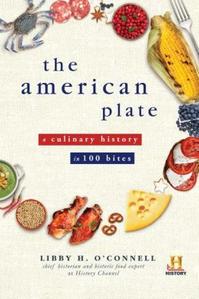
|
|
| photo: Tess Steinkolk | |
Libby H. O'Connell is chief historian and senior v-p of corporate responsibility for the History Channel and A&E networks, and has produced more than 40 short films for museum exhibitions around the country. She received her M.A. and Ph.D. in history from the University of Virginia, serves on the boards of several organizations, and is the author of The American Plate: A History of the United States in 100 Bites (Sourcebooks), reviewed below. She lives near New York City.
How did you come to choose food as your vehicle for relating history?
I was an interpreter at Plymouth Plantation while I was a student at Boston College in the 1970s. Plantation life was depicted as real, not "quaint," and I worked in the "food" house," the most active spot, where we milked and churned. Every visitor could relate to food. David McCullough said, "Great history is made of great stories," and around the table is where the best stories were told. So I wrote my book for people who like both food and stories!
The American Plate has an unusual layout--your nine chapters represent eras in American history, and within each chapter are 10 smaller "bites," plus sidebars with historic detail. Did you have a specific audience in mind when you designed the book?
You can open it anywhere you want! It can be read in order--as a chronological history--or it can stay by the bed and be read to avoid thinking about heavier news of the day. I wrote it for my friends who aren't historians, to give a colorful mosaic of rich and varied images of American character.
What aspects of history stand out?
There are two sides to food history--at Monticello, for example, Jefferson's beautiful gardens (pictured in The American Plate) were terraced by slaves. But one reason I'm a food historian is there's no need to prove it's relevant. I empathize deeply with the past and love to illustrate that people who wore different clothes aren't dusty characters. The recipes reflect the economic condition of their times--Southerners ate catfish (recipe included) and game when the Union strategy to destroy their food supply left them little else.

I tested all the recipes, but pie is especially interesting. Historically, it's about the contents, not the crust. In the 1500s what we call a crust was called a "coffin" and a cookbook instructed "put the chicken in the coffin." It wasn't meant to be eaten, and was tough, cardboard-like stuff... unless you were rich and had access to butter. There was so much to include in the book that I almost left out chili, but I thought of the post-9/11 documentaries I'd worked on and went to the firehouse that had lost the most firefighters and asked if they'd share their recipe.
The American Plate is chock-full of history and stories. How did you research and organize hundreds of years of information?
I've collected cookbooks and books on food and daily life for 40 years. Reading--from old letters to novels--filled in the stories. "We were at the steakhouse" gives an insight to a time and place. I wrote the book by hand on lined paper, and each chapter was a pad.
If you were asked to name one representative "American cookbook" or define "American cuisine," what would you say?
For the cookbook, probably the 1975 Joy of Cooking. For "American cuisine," there's no simple answer. A visitor might think of the ease and economy of on-the-road food, but that's not recognizing the local and seasonal offerings. But we have the California school of food, local and fresh; and Brooklyn, headquarters of the slow food movement.... American cuisine: the regionality of it! Little Rock, Arkansas, has the Capitol Victorian Hotel, serving audaciously fabulous local food. And now we have Thai food down the street, and there's wonderful Vietnamese food in Boston! --Cheryl Krocker McKeon, manager, Book Passage, San Francisco

